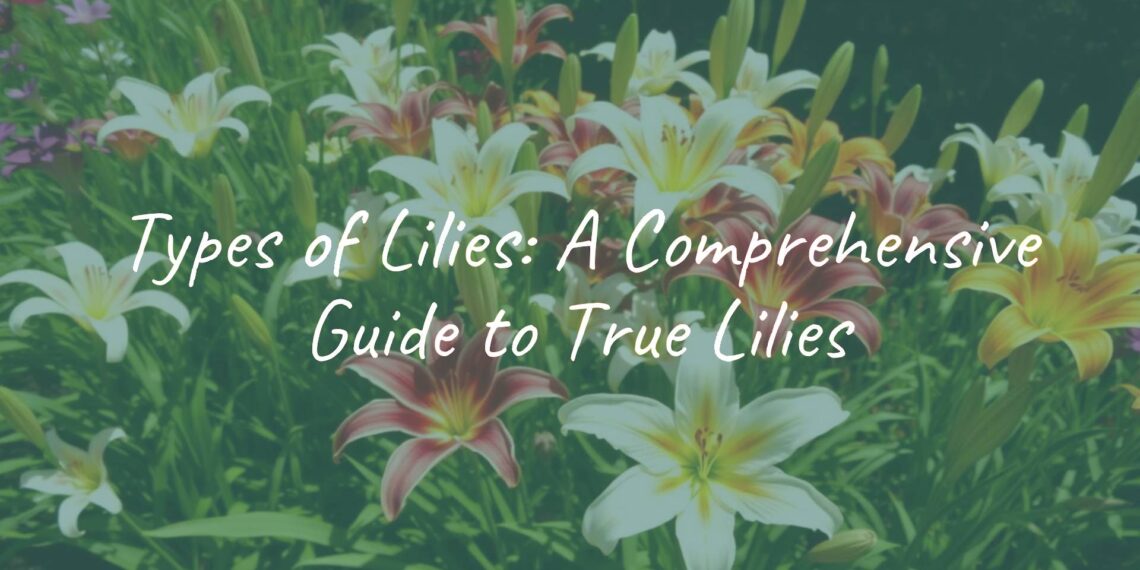When you hear “lily,” you might picture big, trumpet-shaped flowers with a strong scent, either in garden beds or in a bouquet. But what counts as a “true lily,” and how many kinds are there? True lilies belong to the genus Lilium. This group includes close to 100 species and thousands of hybrids. They come in many colors, forms, and sizes, so there is a lily for almost any style and growing spot. Some are tall, some are short, some are lightly scented, and some are very fragrant. With so many choices, true lilies are a favorite for many gardeners.
There are over 2,000 lily varieties, showing how popular they are and how much breeding has shaped them. This guide explains what makes a true lily, how they are grouped, and highlights many well-loved types you are likely to see.
What Are True Lilies?
True lilies are perennials that grow from bulbs made of fleshy, layered scales. This feature sets them apart from many plants that carry “lily” in their name but are not part of Lilium. True lilies are known for large blooms, often with a pleasant scent, that appear in spring or summer.
The genus Lilium includes more than 80 species plus many hybrids. While a few need special care, most are easy to grow, so they suit beginners and experienced gardeners alike. Their mix of beauty, variety, and simple care has kept them in gardens for ages.
How to Identify True Lilies
Spotting a true lily (Lilium) is simple once you know the signs. The bulbs are made of soft, overlapping scales and have no papery covering. Because of this, lily bulbs should be kept slightly moist before planting so they do not dry out.
Flowers are usually large and showy. Shapes range from trumpets to stars, and the blooms may face up, out, or down. Many have a sweet or spicy scent. Leaves often grow in whorls or spirals along the stem. These clues help you tell a true Lilium from plants that only share the word “lily” in their common name.

Common Confusions: Daylilies and Other Lily-Like Flowers
Many plants are called “lily” but are not true lilies. The most common example is the daylily (Hemerocallis).
Daylily flowers look similar at first glance, but they last just one day. A daylily plant can still bloom for weeks because it opens new flowers daily. True lily blooms last several days each. Also, daylilies grow from fibrous roots, not scaly bulbs. Other plants often mistaken for lilies include calla lily (Zantedeschia aethiopica), lily-of-the-valley (Convallaria majalis), water lily (Nymphaea), and peace lily (Spathiphyllum). These are lovely plants, but they come from different families and do not share the key traits of Lilium. This distinction matters for pet safety too: many true lilies, like ‘Stargazer’ and Easter lily, are toxic to cats, while some “lily-like” plants are not.

How Are Lilies Classified?
With so many lilies and hybrids, a clear system helps gardeners and botanists sort them out. The North American Lily Society and the Royal Horticultural Society group lilies into nine horticultural divisions. These divisions focus on features like flower direction (which way the flowers face), shape, growth habits, and parentage.
These groups make it easier to learn about each lily’s traits, preferred conditions, and how they might be crossed. You do not need every detail to appreciate how rich and varied the lily group is.
Major Lily Groups and Hybrids
Some groups are very popular and widely grown. Asiatic and Oriental lilies are among the most common in home gardens due to their striking looks and wide range of choices. Breeders have also created many crosses that mix traits from different groups.
Other well-known groups include Trumpet lilies with long, tubular blooms and Martagon lilies (Turk’s caps) with curled-back petals. Crosses between groups add even more options. Orienpet lilies combine Oriental and Trumpet traits, bringing scent, height, and toughness together. LA hybrids mix Easter lilies (Lilium longiflorum) with Asiatic types for bold colors on strong stems. Ongoing breeding brings fresh lily types year after year.
| Group | Scent | Bloom time | Typical height | Notes |
|---|---|---|---|---|
| Asiatic | Little to none | Early to mid-summer | 1-5 ft | Very easy to grow; wide color range |
| Oriental | Strong | Mid to late summer | 2-6+ ft | Large blooms; prefers slightly acidic, rich soil |
| Trumpet | Strong | Mid-summer | 4-8 ft | Tall, tubular flowers; may need staking |
| Orienpet | Moderate to strong | Mid-summer (often earlier than Orientals) | 4-8 ft | Mix of Oriental scent and Trumpet vigor |
| LA Hybrid | Light | Late spring to early summer | 2-4 ft | Bold colors; good cut flowers |

Differences Between Wild and Cultivated Lilies
Species lilies grow in nature in set regions. They have a natural look and are adapted to their home habitats. Examples include the Madonna lily (Lilium candidum) from the Balkans and the Goldband lily (Lilium auratum) from Japan.
Garden lilies are often hybrids made by crossing species to get bigger flowers, brighter colors, longer bloom times, or better disease resistance. Species show the original look of lilies, while hybrids offer the flashy displays many gardeners want. For example, wild Regal lilies are white, but breeding has added many colors. The mix of nature and careful selection keeps adding to the range of lilies we can grow.
Common Types of Lilies and Their Features
With so much variety, you can find a true lily to fit almost any garden. Some are bold and easygoing; others are refined and richly scented. Below are common and well-loved types, with their key traits.
Asiatic Lilies: Colorful, Easy-to-Grow Varieties
Asiatic lilies are great for beginners. They have vivid colors-orange, yellow, red, pink, purple, and bicolors-and many have little or no scent. Flowers can face up, out, or down, adding interest to beds and pots.
- Bloom: June-July
- Height: 1-5 ft; good for borders and containers
- Zones: USDA 3-8; hardy and quick to multiply
- Popular picks: ‘Lollipop’, ‘Buff Pixie’ (dwarf), ‘Purple Eye’, ‘Orange’, ‘Forever Susan’
- Tip: Double-petaled forms have less pollen, helpful for allergy-sensitive folks
Oriental Lilies: Fragrant, Large Blooms
If you want scent, choose Oriental lilies. Their sweet, sometimes spicy aroma can fill the garden, especially in the evening. They bloom later than Asiatics and put on a big show in late summer.
- Bloom: July-September
- Flower colors: white, pink, red, salmon; often with speckles or borders
- Popular picks: ‘Stargazer’, ‘Casa Blanca’, ‘Muscadet’, ‘Tiger Woods’
- Soil: prefers rich, slightly acidic soil; large flowers (up to 12 inches)
- Use: excellent cut flowers; petals often spread out from the stem

Trumpet Lilies: Elegant, Tubular Flowers
Trumpet (Royal/King’s) lilies carry long, trumpet-shaped blooms with a heavy, sweet scent. They start in mid-June and can flower into August. Petals curl slightly, and blooms face out from tall, sturdy stems.
- Colors: beyond the classic white-pink, plum, apricot, gold, yellow, chartreuse
- Height: 4-8 ft; often need staking in wind
- Popular picks: ‘African Queen’ (orange with purple), ‘Golden Splendour’ (yellow)
Orienpet Lilies: Hybrid Beauty and Strength
Orienpet lilies blend the scent and height of Orientals with the tough growth of Trumpets. They often have large, trumpet-shaped flowers around 8 inches wide and come in many colors.
- Bloom: mid-summer, often earlier than pure Orientals
- Height: many reach 6-8 ft
- Popular picks: ‘Purple Lady’, ‘Scheherazade’ (red petals with gold edges)
LA Hybrid Lilies: Long-Lasting, Vibrant Colors
LA hybrids come from crossing Easter lily (Lilium longiflorum) with Asiatic types. They have sturdy stems, broad, slightly trumpet-shaped blooms, and a light scent. Their color range is wide, including pink, red, orange, yellow, white, plus bicolors and speckled forms.
- Bloom: late spring to early summer
- Light: full sun to partial shade
- Use: great cut flowers that last well in a vase
Martagon Lilies (Turk’s Cap): Unique Downward-Facing Flowers
Martagons carry many small, nodding flowers with petals curled far back, like a cap. They can grow 3-6 ft tall, and in the right spot can reach over 6 ft.
- Colors: yellow, gold, orange, pink, lavender, deep red, often spotted
- Bloom: late May or June through August
- Light: good for dappled shade; avoid crowded tree roots
- Popular picks: ‘Album’, ‘Pink Morning’, ‘Orange Jam’
Easter Lilies: Classic White Blooms
The Easter lily (Lilium longiflorum) is well known as a holiday plant, but it also shines in the garden. It has outward-facing, trumpet-shaped white flowers with a strong scent and a hint of green at the base.
- Bloom (outdoors): July-August if not forced earlier
- Height: about 3 ft
- Soil: does well in calcareous soil and a sheltered spot
- Popular picks: ‘Nellie White’, ‘White Heaven’
Tiger Lilies: Spotted Orange Flowers
The Tiger lily (Lilium lancifolium) shows bright orange blooms with dark spots, like a tiger’s coat. It grows well in sun, partial shade, or even shade.
- Bloom: June-August; up to 10 flowers per stem
- Flower form: nodding blooms with curled-back petals (Turk’s cap style)
- Key trait: small bulblets form in leaf axils along the stem
- Height: about 3 ft; naturalizes easily; good disease tolerance
- Popular picks: ‘FlorePleno’ (double orange), ‘Splendens’ (orange to peach)

Madonna Lilies: Historic Pure White Flowers
The Madonna lily (Lilium candidum) has been grown for more than 2,000 years and carries strong symbolism, often linked with purity. It bears pure white, outward-facing trumpets with bright yellow pollen.
- Bloom: late spring to early summer
- Height: about 3 ft
- Site: sheltered, morning sun preferred; neutral, loose, calcareous soil
- Care: benefits from some winter protection
Regal Lilies: Majestic White Trumpets
Regal (Royal/King’s) lilies are tall and showy, with big, trumpet-shaped flowers and a strong, sweet scent. While the wild form is white, breeding has added pink, purple, apricot, and gold tones, often with contrasting throats.
- Bloom: mid-June onward
- Height: up to about 5 ft
- Popular picks: ‘African Queen’, ‘Golden Splendour’
Golden-Rayed Lilies: Japanese Goldband Blooms
The Golden-Rayed lily (Lilium auratum), also called Goldband lily, comes from Japan. It has huge, fragrant white flowers with yellow midribs and red or brown spots. Blooms can reach 10 inches across.
- Bloom: August-September
- Height: up to 8+ ft
- Site: likes cool, moist spots; partial shade in hot areas
- Lifespan: often 3-4 years; worth growing for the stunning display
Henry’s Lilies: Twisted-Leaf, Orange Blooms
Henry’s lily (Lilium henryi) is from China and is a parent of several popular hybrids. It has nodding, unscented, light orange flowers with maroon spots. Petals often curve or twist back.
- Bloom: mid to late summer
- Height: 4-8 ft; may lean and need staking
- Light: full sun to partial shade; well-drained soil
Fire Lilies: Vivid Summer Color
The Fire lily (Lilium bulbiferum), also called Orange lily, St. John’s lily, or Jimmy’s Bane, is a European species with bright orange or red flowers, often speckled with brown. Its blooms face up in umbels, unlike many other lilies.
- Bloom: May-July; up to 20 flowers per plant
- Height: about 3 ft
- Soil: sunny sites with slightly calcareous soil
- Trait: can form secondary bulbs in leaf axils
Leopard Lilies: Striking Spotted Varieties
The Leopard lily (Lilium pardalinum) is native to California and southern Oregon. It grows near streams, in bogs, and in open woods. Flowers are Turk’s cap-shaped in yellow, orange, or red, and heavily spotted with brown or maroon.
- Bloom: May-July
- Height: 6-8 ft; forms colonies without becoming invasive
- Soil: lime-free; full sun to partial shade
- Bonus: produces abundant pollen and draws many helpful insects
Canada Lilies: Native North American Species
The Canada lily (Lilium canadense)-also called Wild Yellow Lily-is native to eastern North America. It carries nodding, trumpet-shaped flowers in speckled yellow, orange, or red. Plants can produce up to 20 blooms in early to mid-summer.
- Height: over 3 ft
- Moisture: one of the few lilies that likes boggy conditions
- Light: dappled shade; prefers lime-free soil
- Wildlife: attracts bees, butterflies, and ruby-throated hummingbirds
Wood Lilies: Bright Orange Woodland Flowers
The Wood lily (Lilium philadelphicum)-also called prairie lily or Philadelphia lily-is a smaller native with up-facing, funnel-shaped orange-red blooms and brown mottling near the base.
- Bloom: July-August
- Height: 1-2 ft
- Site: good for dry sites in native plant gardens; full sun to partial shade
- Use: eye-catching cut flower for late-summer bouquets
Washington Lilies: Showy Northwestern Species
The Washington lily (Lilium washingtonianum), or Shasta lily, grows in dry woodlands of Oregon and California. It bears large, fragrant, trumpet-shaped white flowers that may blush pink as they age.
- Bloom: late spring to early summer; flowers can last into August
- Height: 2-8 ft
- Soil: well-drained; full sun to partial shade
- Grown abroad: widely cultivated beyond its native range due to its adaptability
Carpet Border Lilies: Compact, Low-Growing Types
Carpet Border lilies are low-growing cultivars (mostly Asiatic) bred to form a colorful, ground-hugging display. They are perfect along paths, in front of borders, or in pots.
- Height: 12-18 inches
- Colors: mixes of red, pink, white, and yellow
- Bloom: early to mid-summer, often lasting into August
- Care: full sun to partial shade; well-drained soil
- Perennial bulbs: return each year and often attract pollinators
Lilies offer an amazing mix of colors, shapes, and scents. From the classic look of the Madonna lily to the bold spots of the Tiger lily, the Lilium genus gives gardeners many paths to create a striking display. Whether you want the easy care of Asiatic types or the rich perfume of Orientals, you can find a lily that fits your space.
Across many cultures, lilies stand for purity, renewal, and even royalty. This adds meaning to their beauty. For best growth, give most lilies at least six hours of sun each day-morning sun with light afternoon shade works well-and soil that drains well. Tall types may need stakes. Overall, they are low-care plants once settled in. Bring lilies into your garden and let their color and scent make your space shine each season.
















![What to with Scrap Metal? [infographic]?](https://facts-homes.com/wp-content/uploads/2019/07/645413-POPYOV-391-120x86.jpg)






